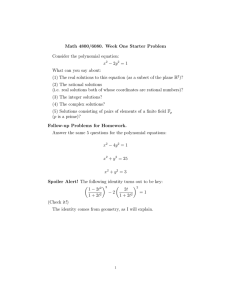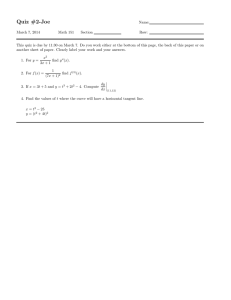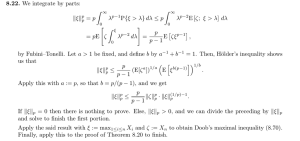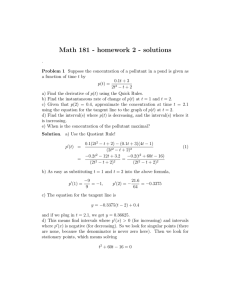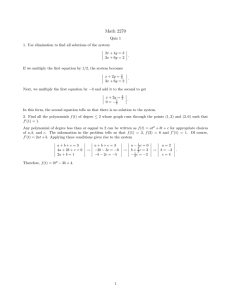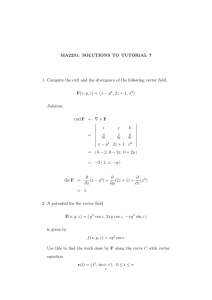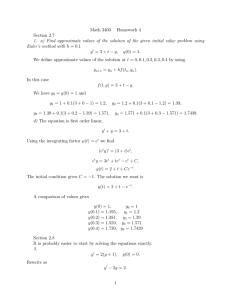L Lecture 23 Theory May 11th, 2004
advertisement
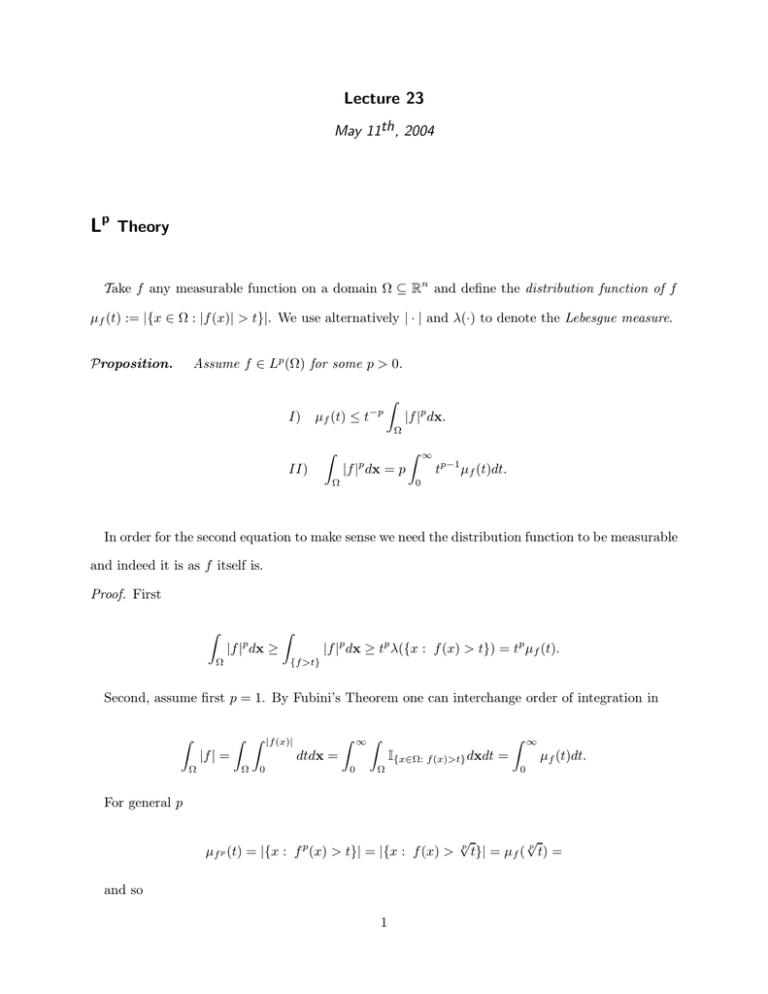
Lecture 23
May 11th , 2004
Lp Theory
Take f any measurable function on a domain Ω ⊆ Rn and define the distribution function of f
µf (t) := |{x ∈ Ω : |f (x)| > t}|. We use alternatively | · | and λ(·) to denote the Lebesgue measure.
Assume f ∈ Lp (Ω) for some p > 0.
Proposition.
I)
µf (t) ≤ t−p
II)
Z
Z
p
Ω
Ω
|f |p dx.
|f | dx = p
Z
∞
tp−1 µf (t)dt.
0
In order for the second equation to make sense we need the distribution function to be measurable
and indeed it is as f itself is.
Proof. First
Z
Ω
p
|f | dx ≥
Z
{f >t}
|f |p dx ≥ tp λ({x : f (x) > t}) = tp µf (t).
Second, assume first p = 1. By Fubini’s Theorem one can interchange order of integration in
Z
Ω
|f | =
Z Z
Ω
|f (x)|
dtdx =
0
Z
∞
0
Z
I{x∈Ω: f (x)>t} dxdt =
Ω
Z
∞
µf (t)dt.
0
For general p
µf p (t) = |{x : f p (x) > t}| = |{x : f (x) >
and so
1
√
p
√
p
t}| = µf ( t) =
p
Z
∞
t
p−1
µf (t)dt =
0
Z
∞
p
p
µf p (t )d(t ) =
0
Z
Ω
|f |p dx.
Let 1 ≤ q < r < ∞ and let T : Lq (Ω) ∩ Lr (Ω) −→
Marcinkiewicz Interpolation Theorem.
Lq (Ω) ∩ Lr (Ω) be a linear map. Suppose there exist constants T1 , T2 such that
∀ f ∈ Lq (Ω) ∩ Lr (Ω)
µT f (t) ≤
T ||f || q q
1
L (Ω)
,
t
µT f (t) ≤
T ||f || r r
2
L (Ω)
,
t
∀ t > 0.
Then for any exponent in between q < p < r, T can be extended to a map Lp (Ω) −→ Lp (Ω) for all
f ∈ Lq (Ω) ∩ Lp (Ω). And moreover,
||T f ||Lp (Ω) ≤
h p
i p1
p
(2T1 )q +
(2T2 )r ||f ||Lp (Ω) .
q−p
r−p
Otherwise stated: weak (q, q) & weak (r, r)
=⇒
strong (p, p) p ∈ (q, r), though not for the
endpoints, the constants blow-up there (we say an operator is strong (p1 , p2 ) if it maps functions
in Lp1 to functions in Lp2 . We say it is weak (p1 , p2 ) if its domain is in Lp1 and its distribution
function satisfies the first inequality in the assumptions above with q replaced by p2 ).
Proof. Take f ∈ Lq (Ω) ∩ Lr (Ω), and let s > 0. Let
f1 :=
f (x) |f (x)| > s
0
|f (x)| ≤ s
f2 :=
0
|f (x)| > s
f (x) |f (x)| ≤ s
indeed one notices that f = f1 + f2 . The trick will be to let this splitting of f vary by letting s
itself vary. So |T f | ≤ |T f1 | + |T f2 |. If T f (x) > t at some point x ∈ Ω then either T f1 > t/2 or
T f2 > t/2. This translates into
2
µT f (t) ≤ µT f1 (t/2) + µT f2 (t/2)
T q Z
1
≤
t/2
q
|f1 | +
Ω
T r Z
2
t/2
Ω
|f2 |r .
We choose the smaller exponent q for the terms where f is large (f1 ) and larger one r for where f
is small (f2 ), intuitively. This will make sense in a moment when it will be clear how this guarantees
that our two integrals — with different integration domains — are finite. By the Proposition we
have
Z
p
Ω
|T f | dx = p
Z
∞
tp−1 µT f (t)dt.
0
and once we substitute in the above inequality we get
Z
Ω
p
|T f | dx ≤ p
∞
Z
t
p−1
= p(2T1 )
1
t/2
0
q
h T q Z
Z
∞
Z
q
Ω
i
|f2 |r dt
2
t/2
Ω
Z
p−1−q
r
|f1 | t
dt + p(2T2 )
∞
q
{|f |>s}
0
|f1 | +
T r Z
0
Z
{|f |≤s}
|f2 |r tp−1−r dt.
We chose s > 0 arbitrary in the above construction of fi . In particular we may let it vary. This
is a neat trick. We set s = t to get
q
p(2T1 )
∞
Z
0
q
= p(2T1 )
= (2T1 )q
Z
Z
{|f |>s}
q
Ω
|f | dx
p
q−p
Z
p−1−q
r
ds + p(2T2 )
|f | s
∞
q
Z
Ω
Z
0
|f |
s
p−1−q
r
ds + p(2T2 )
0
Z
Ω
|f |p + (2T2 )r
p
r−p
Z
Ω
Z
r
|f | dx
{|f |≤s}
Z
|f |r sp−1−r ds
∞
sp−1−r ds
|f |
|f |p .
Altogether
Z
Ω
|T f |p dx ≤
i Z
h p
p
|f |p .
(2T1 )q +
(2T2 )r ·
q−p
r−p
Ω
3
Remark.
In Gilbarg-Trudinger, p.229, a different constant is achieved which is slightly stronger
than ours (as can be seen using the AM-GM Inequality). This is done by introducing an additional
constant A, letting t = As and later choosing A appropriately.
Back to the Newtonian Potential
We defined the Newtonian Potential of f
Z
ω ≡ N f :=
Claim.
Ω
Γ(x − y)f (y)dy =
1
n(2 − n)ωn
Z
Ω
1
dy.
|x − y|n−2
N : Lp (Ω) −→ Lp (Ω). Moreover continuously so– ∃ C such
(Young’s Inequality)
that ||N f ||Lp (Ω) ≤ C||f ||Lp (Ω) .
Remark.
For p = 2 we proved in the past much more: ∆(N f ) = f ∈ L2 (Ω) ⇒ N f ∈ W 2,2 (Ω).
Also our previous estimates on the Newtonian Potential can actually be made to extend our Claim
to W 1,p (Ω) regularity. These estimates can not give though W 2,p (Ω) estimates (see the beginning
of the next Lecture).
Proof.
ω : =Γ⋆f =
Z
Ω
=
Z
1
≤
Z
≤C·
1
f (y)Γ(x − y) p Γ(x − y)1− p dy
Ω
Γ(x − y)f (y)dy
p
Ω
|f (y) Γ(x − y)|dy
Z
Ω
p1 |f (y)p Γ(x − y)|dy
4
Z
Ω
p1
.
|Γ(x − y)|dy
1− p1
since Γ(x − y) ∼
1
and therefore is integrable over Rn . Therefore we have an upper bound
|x − y|n−1
on ω p which we can integrate
Z
p
Ω
ω dx ≤
Z
C
p
Ω
=C
p
≤ C̃
Ω
Z Z
Ω
= Cp
Z
Z
Z
Ω
|f (y)|p |Γ(x − y)|dxdy
|f (y)|p
Ω
Ω
|f (y)p Γ(x − y)|dy dx
Z
Ω
|Γ(x − y)|dx dy
|f (y)|p dy.
where we applied Fubini’s Theorem.
T heorem.
Let f ∈ Lp (Ω) for some 1 < p < ∞ and let ω = N f be the Newtonian Potential of
f . Then ω ∈ W 2,p (Ω) and ∆w = f a.e. and
||D2 w||Lp (Ω) ≤ c(n, p, Ω) · ||f ||Lp (Ω) .
For p = 2 we have even
Z
2
Rn
2
|D ω| =
Z
f 2.
Ω
Proof. We prove just for p = 2, leaving the hard work for the next and last lecture. First we assume
f ∈ C0∞ (Rn ). From long time ago: f ∈ C0∞ (Rn ) ⇒ ω ∈ C ∞ (Rn ) and ∆ω = f (Hölder Theory for
the Newtonian Potential).
Let B := BR a ball containing suppf
Z
⇒
2
(Dω) =
BR
Z
BR
We embark now on our main computation
5
2
f =
Z
Ω
f2
(1)
Z
2
BR
2
|D ω| =
Z
BR
Dij ωDij ω (summation) = −
Z
=−
Z
=−
Z
=
=
Z
Z
BR
Z
∂BR
BR
Z
∂BR
Dj (Dij ω)Di ω +
Di (Djj ω)Di ω +
Di (∆ω)Di ω +
BR
BR
(∆ω)2 −
2
(∆ω) +
Dij ωDi ωνj dθ
∂BR
∂
DωDωdθ
∂ν
∂
ωdθ +
∂ν
Z
∆ω ·
Z
∂
Dω · Dωdθ.
∂ν
∂BR
∂BR
BR
Z
Dij ωDi ωνj dθ
Z
∂BR
∂
Dω · Dωdθ
∂ν
The last equality results from our assumption that f vanishes on ∂B, i.e has compact support
inside Ω. Now since f is smooth
Di ω(x) =
Z
Di Γ(x − y)f (y)dy ≤
C
,
Rn−1
Z
Dij Γ(x − y)f (y)dy ≤
C
.
Rn
Ω
Dij ω(x) =
Ω
Therefore as we let R −→ ∞, the second term - which is integrated only over the sphere of radius
R in Rn – tends to 0. Then we have in the limit the desired result (after substituting (1) for the
rhs).
Now if f ∈ L2 (Ω), approximate it by functions fm ∈ C0∞ (Rn ) (possible by the density argument
2
used in the past: C0∞ (Ω) = L2 (Ω)) such that fm −L
−−(Ω)
−→ f . From the Claim above ||N f ||Lp (Ω) ≤
2
C||f ||Lp (Ω) , hence ||N (fi − fj )||Lp (Ω) ≤ C||fi − fj ||Lp (Ω) , from which ωm ≡ N fm −L
−−(Ω)
−→ N f ≡ ω.
Now ∆ωj = fj and by the C0∞ (Ω) case applied to the Dirichlet Problem ∆(ωi − ωj ) = fi − fj
Z
R
|D2 (ωi − ωj )|2 =
n
6
Z
Ω
|fi − fj |2 .
As the rhs tends to 0 for i, j large we have that {D2 ωm } converges in L2 (Ω), i.e {ωm } converges in
W 2,2 (Ω). Since we already know its limit is ω ∈ L2 (Ω) we conclude that in fact ω ∈ W 2,2 (Ω) !
7
